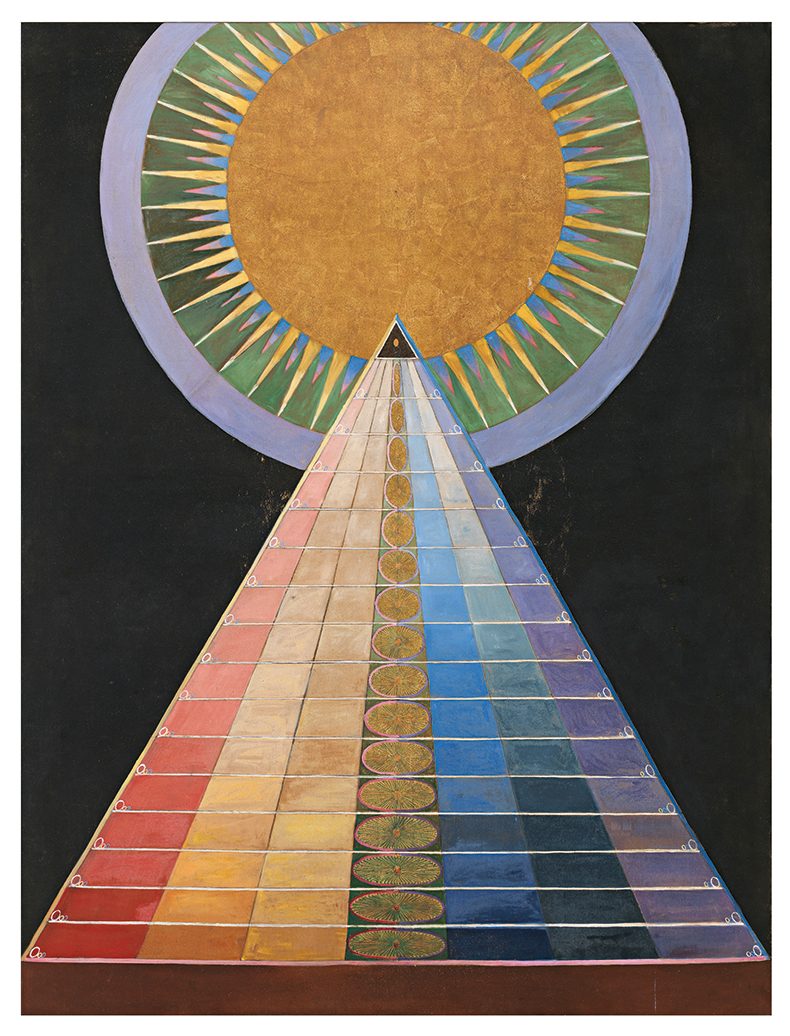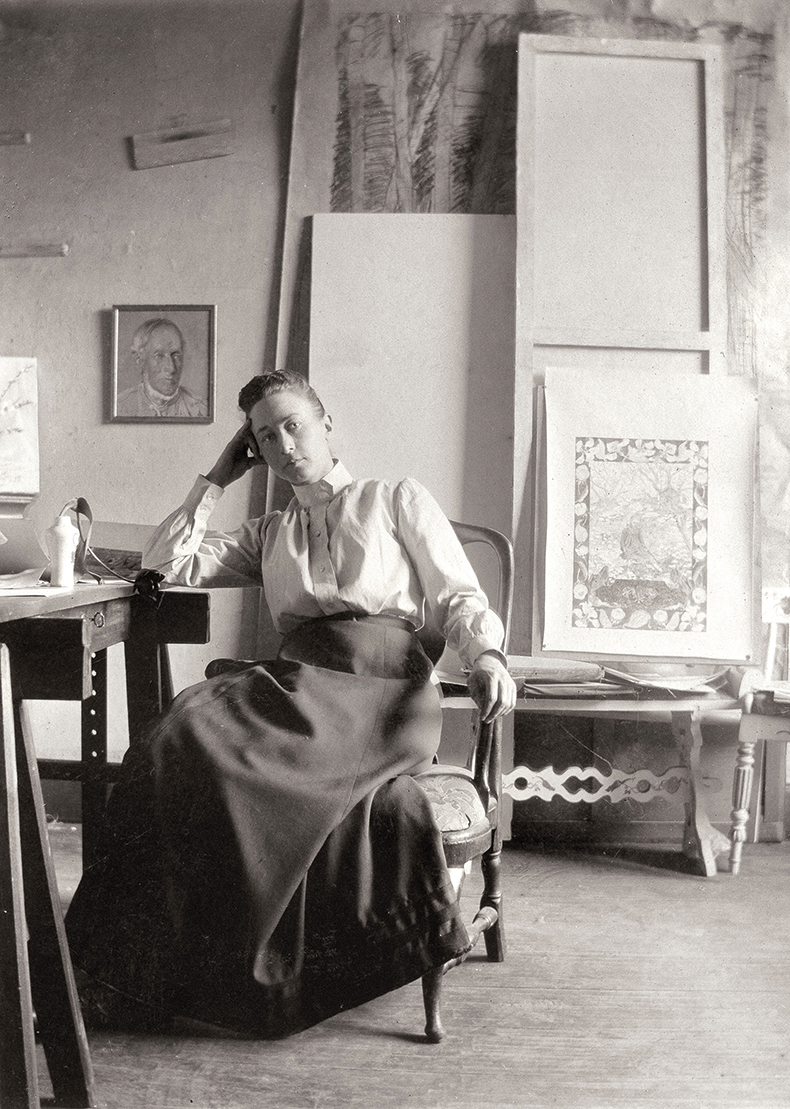From the April 2023 issue of Apollo. Preview and subscribe here.
Early this year I criss-crossed Sweden by train. Borne through the feathery, leafless haze of birch forests, between lake after endless frozen lake, I traversed a floating world balanced between air and water. The earth beneath felt more membrane than solid mass. In Stockholm, the water charged between islands – wild energy coursing around this clever, curlicued city. The natural world is never far – nor, perhaps, the supernatural.
Strange things happen when northern light hits ice crystals. In 1535 a miracle was reported in Stockholm – multiple suns with radiant haloes crowding the morning sky. The event was commemorated in a painting – Vädersolstavlan – a 17th-century copy of which hangs in the city’s medieval cathedral. It is celebrated as the earliest panorama of the Swedish capital, a distinction that neatly distracts from the work’s supernatural qualities. The upper portion of Vädersolstavlan shows shimmering, overlapping rings studded with hovering spheres. Rendered with cartographic precision, it is a motif worthy of Hilma af Klint and one on view in the church at which her family worshipped on high holidays.
Over the last decade af Klint has emerged as if from nowhere and ascended towards the popular status of Frida Kahlo and Yayoi Kusama. Following an extended world tour and phenomenal solo exhibition at the Guggenheim Museum in New York her paintings are fast becoming ubiquitous. Shortly before Christmas, in sleet-scoured central London, I watched the launch of an immersive spectacle that gives digital form to a spiralling temple-gallery af Klint imagined for her most important series, Paintings for the Temple (1906–15). Influencers took selfies as a fast-changing blur of paintings descended around us. (Afterwards, in a Q&A, devotees grumbled that this other-worldly artist was being used as set-dressing for an expensive new property development.) This spring, af Klint is the star of Daniel Birnbaum’s thematic show Swedish Ecstasy, at Bozar in Brussels, which argues that she should be considered as part of a lineage of Swedish spiritual thought dating back to the 18th-century mystic Emanuel Swedenborg (until 21 May). This month, her work will be shown beside Piet Mondrian’s at Tate Modern (20 April–3 September). More, much more, is in the works. Not bad for an artist who died in obscurity in 1944.
An academically trained artist and a medium – her greatest works were commissioned by a spirit guide encountered during a séance – af Klint was arguably responsible for the earliest abstract paintings in the Western tradition. Her story, as long-term Hilma champion Birnbaum admits, is ‘almost too good to be true […] and has maybe been exaggerated a bit’. Indeed so much embellishment has attached itself to af Klint’s biography that Julia Voss opens her authoritative recent life of the artist with a chapter of myth-busting.

Altarpiece, Group X, No 1 (1915) Hilma af Klint. Hilma af Klint Foundation, Stockholm (on long-term loan to the Moderna Museet, Stockholm). Photo: Moderna Museet, Stockholm
The image of af Klint as an isolated outsider, labouring in secret and refusing to show her work, is certainly exaggerated. She achieved modest success as an artist of landscapes, botanical studies and technical drawings and was aware of new developments in art. In spiritual endeavours she worked with a group of women known as The Five, including her intimate friend Anna Cassel. During regular séances, the group practised automatic drawing and received messages from spirits. Af Klint publicly exhibited her mediumistic works, first in 1913 at the Theosophical Society in Stockholm, and 15 years later in a solo exhibition in London. A cool reception for the latter prompted her notorious instruction that certain works should not be shown until 20 years after her death.
The men in af Klint’s family were celebrated naval cartographers – a delicate and vital skill on the Scandinavian peninsula, with its archipelagic cities and filigree coastline. Af Klint inherited precision and close observation. Her meticulous drafting skills were set to use in technical drawings for a manual on equine surgery made with Cassel in 1900. Look closely, and you’ll notice af Klint borrowing from the graphic language of cartography and scientific diagrams in her pioneering works of abstraction, including the vast and exuberantly coloured sequence The Ten Largest.
In drawings of flowers, mosses and lichens known as the ‘Dornach Set’ (c. 1917–19), af Klint combined observation of the plants’ exteriors with diagrammatic renderings of their inner qualities – portraits of both bodies and souls. Finely attuned to intangible, invisible forces emanating from the natural world, af Klint saw nothing incongruous in the melding of science and spiritualism. Indeed, as Jennifer Higgie points out in her new book on women, art and the occult, The Other Side, the one led to the other. This was the era of the atom, telephony, radio waves and X-rays. Such discoveries raised the question of what other unseen forces might influence our visible world; hence, this was also an era of séances, theosophy and tarot.

Courtesy Hilma af Klint Foundation, Stockholm
Paintings for the Temple was created at the behest of Amaliel, a spirit regularly contacted by The Five during séances. Af Klint described the earlier works in the sequence as having been guided, but the later portions, which include a set of monumental altarpieces exploring chromatic affinities, as more interpretative. She was not merely a vessel channelling forms and ideas – even in her mediumistic works, af Klint retained a sense of author- ship. Voss admits that when she started her biographical research she ‘struggled with the spiritual world she was in – I thought it would have been easier if she’d been a regular avant-garde artist.’ Having imagined af Klint being dictated to by authoritarian spirits, the notebooks offered Voss a different story: ‘She was in dialogue with these forces, they were more like friends than an authority.’
Many pioneers of abstraction were devotees of one or other branch of spiritual thought. Mondrian was a life member of the Theosophical Society and kept a photograph of its charismatic founder Madame Blavatsky. Frantisek Kupka studied theosophical texts, as did Wassily Kandinsky, whose earliest experiments with abstraction in 1910 coincided with the publication of his essay Concerning the Spiritual in Art. None of this sits comfortably alongside the cool, rational story of modern art and its evolution towards abstraction promoted by 20th-century curators. Periodic acknowledgments of abstraction’s other-worldly dimension, such as the exhibition ‘The Spiritual in Art’ (1986) at Los Angeles County Museum of Art, were not universally embraced.
The LACMA show was the first significant posthumous outing for af Klint, shown alongside Kandinsky, Mondrian, Kupka and Malevich. The critic Hilton Kramer was unimpressed, dismissing her inclusion as ‘absurd’ – ‘Af Klint is simply not an artist in their class and – dare one say it? – would never have been given this inflated treatment if she had not been a woman.’
The Tree of Knowledge, The W Series, No. 1 (1913–15), Hilma af Klint. Hilma af Klint Foundation, Stockholm (on long-term loan to the Moderna Museet, Stockholm). Courtesy Hilma af Klint Foundation
Birnbaum, who curated the transformative af Klint show ‘Pioneer of Abstraction’ (2013) when he was director of the Moderna Museet in Stockholm, points out that there had been many earlier moments at which af Klint could have broken though. Exhibitions in Sweden in the 1990s and 2000s, some visited by influential curators, failed to spark widespread interest. What changed? ‘There are all these notes from af Klint saying her paintings are for the future – maybe this future has arrived now?’ says Birnbaum, who recently co-authored a seven-volume catalogue raisonné. ‘It’s not only about her being an early female practitioner of abstraction – although that’s important too […] she’s painting the forms of life as well as the life of forms, and that seems in sync with our environmental concerns.’ Birnbaum sees a connection to recent interest in animism and spiritual ecology led by the philosophers Graham Harman and Timothy Morton, who in turn have influenced artists including Olafur Eliasson.
It might seem that amid art historical clamour for evidence of female greatness, af Klint has risen like Venus on a Baltic clamshell, but as Voss reminds me, this has happened against powerful resistance: ‘Even after the Moderna Museet show, art historians were looking for an excuse to keep art history as it was. Her dates challenge the master story of Western abstraction – that brought a lot of negative feelings.’
In The Other Side, Jennifer Higgie notes renewed interest in the occult and a willingness to embrace alter- native art practices such as automatic drawing. She finds loose parallels between the ‘mistrust of rationality and the powers that be’ in our current moment and the modernist response to the First World War. Now, as in af Klint’s time, there is a hunger for alternative structures and systems, and a revaluation of our relationship to the landscapes and waterways from which she drew such powerful inspiration.
From the April 2023 issue of Apollo. Preview and subscribe here.
Unlimited access from just $16 every 3 months
Subscribe to get unlimited and exclusive access to the top art stories, interviews and exhibition reviews.














![Masterpiece [Re]discovery 2022. Photo: Ben Fisher Photography, courtesy of Masterpiece London](http://zephr.apollo-magazine.com/wp-content/uploads/2022/07/MPL2022_4263.jpg)
The threat to Sudan’s cultural heritage